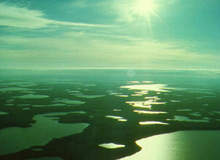
North America has enormous amounts of potential natural gas in underground reserves. As it tries to reduce its dependence on coal, the need for a cleaner and more efficient alternative becomes more pressing. Globally, an estimated 14,000 trillion cubic feet (tcf) of proven and potential natural gas could be converted into synthetic sulphur-free fuel.
Energy reserves are a large part of the USA and Canada’s economic strength, and ensuring perpetual sources of future energy means that North America does not have to rely on foreign import. Annual demand for gas in North America is approximately 25tcf, of which 22tcf is consumed in the USA. By 2010, the gas demand is expected to increase to 34tcf and 30tcf respectively. Vast fields of natural gas reserves were discovered in the Northern Frontiers of Canada and Alaska in the 1970’s, but until now demand was not sufficient to make investment in infrastructure necessary.
PROGRESS IN NORTH AMERICA AND CANADA
Progress of gas exploration and development in the northern parts of the Americas is expected to move quickly over the next 5-10 years, driven by the key companies and producers involved in the energy market. There are two main projects that are being discussed in the Yukon area, the Prudhoe Bay, Alaska gas reserves, and the Mackenzie Delta project. Although the economics of the two projects are seen as stable and robust, there are various political, social and environmental issues that need resolution, however politicians and the energy companies involved believe that in the short-term, only one is feasible.
The reason these vast reserves have not yet been touched is that there is no established markets or infrastructure in place, so any company to develop the region and a workable logistics network would be looking at an incredible investment. Profitability will be affected by the means of getting gas to market, so the producers will decide when and how gas will be transported. A substantial pipeline investment is necessary to pipe the natural gas, ship Liquified Natural Gas (LNG) or pump the diesel-like fluids that could be produced if a gas-to-liquids (GTL) facility was installed in the region.
The largest gas field that has been discovered in the Mackenzie Delta is the Taglu field, with a possible 3tcf, which is a third of proven discovered onshore gas in the region.
MACKENZIE DELTA, CANADA
There is an estimated 9tcf of proven gas reserves in the Mackenzie Delta region in the Northwest Territories (NT) of Canada. In January 2002, a group of oil companies, moved closer to an agreement to develop applications for regulations and a multi-billion dollar pipeline in the Mackenzie Delta region. The pipeline will transport between 800 million to a billion cubic feet of gas per day into Alberta and the USA. The consortium is led by Imperial Oil, who is majority owned by Exxon-Mobil. Imperial is working with Gulf, Mobil Canada and Shell to develop the feasibility studies for the region.
The applicatory regulations are expected to last for a period of three to four years, and cost an estimated $135-$170 million to secure approval and develop a ‘project definition’. If the process runs according to plan, the consortium should be pumping natural gas by 2007-2008. The main bonuses of this option are that the Norman Wells Enbridge pipeline is already established to take the gas part of the way, and because of the distance, the pipeline would cost an estimated $2-3 billion less than from Prudhoe Bay.
PRUDHOE BAY, ALASKA
96% of Alaska’s known gas reserves occur around Prudhoe Bay. Oil has been drilled and transported from the area since the mid-1970’s, but the eight million cubic feet of natural gas which is pumped with the oil is re-injected into the earth because there is no market and no infrastructure available to ship it to market. The companies that are already in the area are BP/Amoco (which operate the largest gas compression facility of its type in the world), Phillips and ExxonMobil.
The bonuses of the Alaskan Highway route are that there is already an established right-of-way and infrastructure from the oil drilling, a proven volume of reserves and a large amount of preparatory regulatory work has already been done.
PIPELINES
While the region’s gas infrastructure is establishing itself, both groups are hoping to use some of the capacity available on the system run by TransCanada Pipelines, who currently operate the main lines delivering natural gas from the western reserves to central Canada and the USA.
The use of the available 1.5 billion cubic feet per day (bcf/d) of TransCanadas’ pipelines are crucial to the success of either project, as neither consortium could afford the initial outlay. It is estimated that whichever consortium loses the right to start drilling first will have to delay their plans by 15 years. The Alaskan fields are proven to have 35tcf, and are estimated to have around 126tcf potential natural gas, while the Mackenzie Delta has a proven 9tcf, and an estimated 42tcf potential gas reserves.
OVERCOMING PERMAFROST PROBLEMS
One of the main technical concerns in developing a pipeline in NT is the permafrost, and the difficulties of burying chilled pipelines. Enbridge has designed, constructed and currently operate buried pipelines that transport chilled oil and gas through the permafrost. Enbridge is the only current operator in NT and has begun the engineering and routing plan for a buried chilled pipeline in the Mackenzie Delta region to northern Alberta.
Enbridge built the first 870km pipeline in NT between 1983-5, between Norman Wells and Fort Simpson at a cost of $330 million. The project was massive, and included contracts with 337 northern firms at a total value of $73.6 million, and 140 NT firms at $31.4 million. If the Mackenzie Delta project goes ahead, this pipeline will link up to Alberta in the south, and the drilling grounds in the north.

